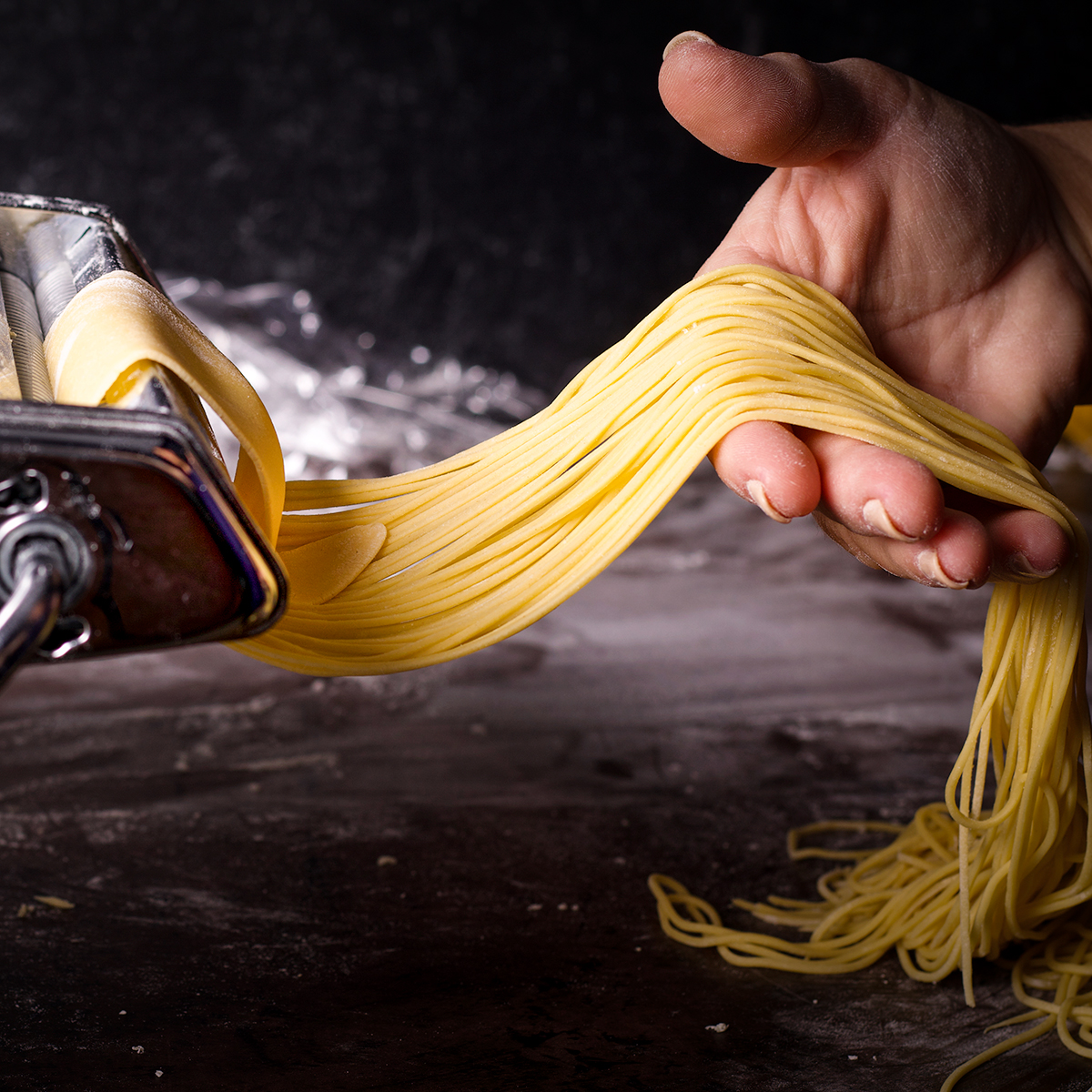Homemade Pasta Recipe Ingredients
To make delicious fresh pasta at home, you only need 4 ingredients, all of which you probably already have on hand:
- All-purpose flour: This homemade pasta recipe disproved my previous belief that you need semolina or 00 flour to make delicious fresh pasta. Every time you use regular all-purpose flour in it, you get chewy, bouncy noodles.
- The secret to giving the dough richness and moisture is eggs!
- Olive oil: A small amount of olive oil moistens the dough and aids in its coming together, along with the eggs.
- For the best flavor, add salt to both the pasta water and the dough.
Find the complete recipe with measurements below.
How to Make Pasta
When you’re ready to make pasta, start by following this detailed tutorial, and then scroll down to the full recipe!
Using the flour, first create a nest on a spotlessly clean surface. With a fork, gently break up the eggs and add the remaining ingredients to the center. Make every effort to preserve the integrity of the flour walls!
Next, use your hands to gently mix in the flour. To form the dough into a shaggy ball, keep working it.
After that, knead the dough for 8 to 10 minutes, or until it becomes smooth and cohesive. At first, the dough should feel fairly dry, but keep going!
If the dough still seems too dry, add some water to your fingers and knead the wet mixture into the dough. Add more flour to your work surface if the dough gets too sticky.
Form the dough into a ball once it comes together and cover it with plastic wrap. Let the dough rest at room temperature for 30 minutes.
After the dough rests, slice it into 4 pieces.
Form one into an oval disk by gently pressing it with your hands or a rolling pin.
Then, run it through the widest setting of your pasta maker (level 1 on the KitchenAid attachment). I run the dough through the pasta maker 3 times on this setting before proceeding to the next step. If you don’t have the KitchenAid attachment, roll out the dough according to your pasta maker’s instructions.
Next, fold the dough… if you want to. This step is kind of optional, but it will shape your finished pasta sheet into a rectangle, which will result in longer pasta strands. It’s also very easy: just spread the dough out and bring the two shorter ends together in the middle.
Then, fold it in half lengthwise to form a rectangle.
Once you’ve folded the dough, roll it out to your desired thickness. On my KitchenAid attachment, I run it through the pasta roller three times on level 2, three times on level 3, and one time each on levels 4, 5, and 6.
Repeat these steps with the remaining dough pieces. Place one half of each piece of dough that you have finished on a baking sheet that has been lightly floured. Dust the dough with flour, then fold the remaining portion over. Sprinkle the top with flour, too!.
Finally, cut and cook the pasta. Run the pasta sheets through your desired pasta cutter attachment. After cooking the noodles for a minute in a pot of boiling salted water, enjoy!
About egg yolk pasta
When I first learned how to make pasta years ago, I used whole eggs instead of primarily egg yolks. I didn’t question it because it was so much better than the dried packaged pasta I’d been using.
One day I came across the recipe for Thomas Kellers pasta in The French Laundry Cookbook and was startled to learn that he only uses one whole egg and then 250 grams of egg yolks per 500 grams of flour. I tried it immediately and havent looked back. Heres what I love about egg yolk pasta:
- Its more flavorful. Egg yolks have more flavor than egg whites. Thus, it stands to reason that pasta with more egg yolks than egg whites will taste better.
- Egg yolk pasta has a more appetizing appearance. I adore adding ground sumac to scrambled eggs, but it gives them a terrible grey look that you really have to try not to notice if you want to truly enjoy them. We perceive food differently depending on its color, and colorful noodles just seem more enticing and tasty. When you make pasta primarily with egg yolks, particularly with farm-fresh, free-range eggs that have vibrant yellow-orange yolks, the pasta absorbs the yolks’ beautiful color and appears just as appetizing as it tastes.
- Its more nutritious. Please refrain from making any dietary suggestions or nutritional claims; I’m not trying to make any. What I’m trying to say is that egg yolks are higher in protein and other nutrients—like calcium, iron, zinc, copper, manganese, vitamin B6, folate, and vitamin B12—than egg whites.
However, there’s no reason you shouldn’t give it a try if you’re dubious. Six large egg yolks and one large egg are needed for this pasta recipe. That amounts to about 140 grams in total. Measure out this amount in whole eggs (roughly three whole eggs), then follow the recipe to make a batch of homemade spaghetti noodles. Next, combine one whole egg and six egg yolks to make a batch. Compare the two versions and see which one you prefer.
